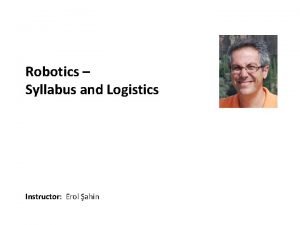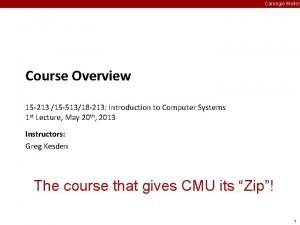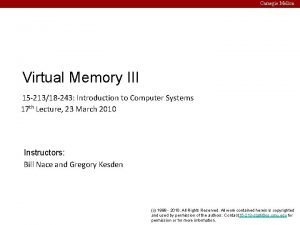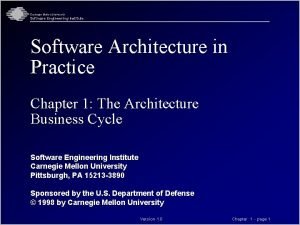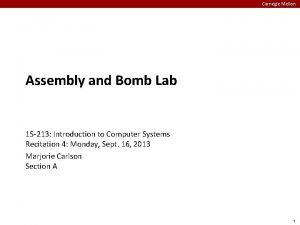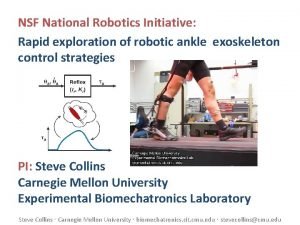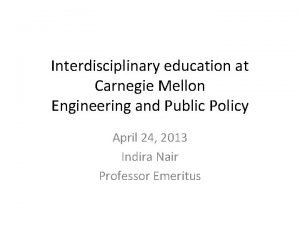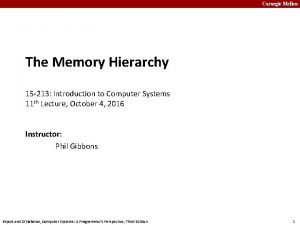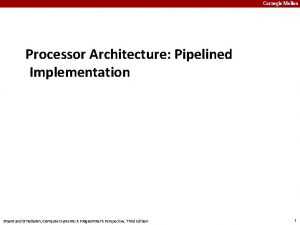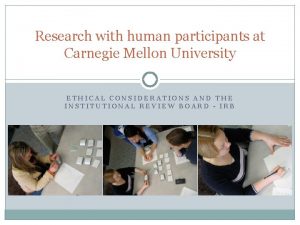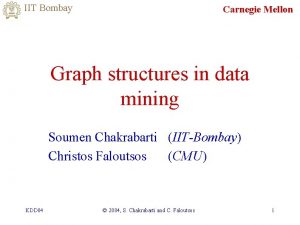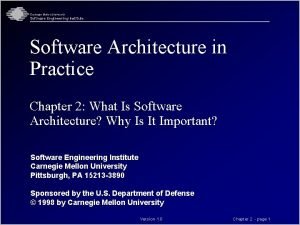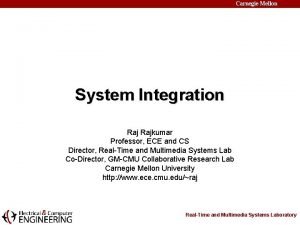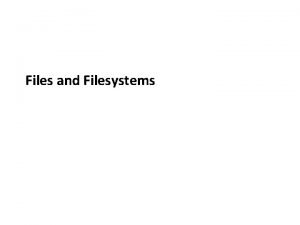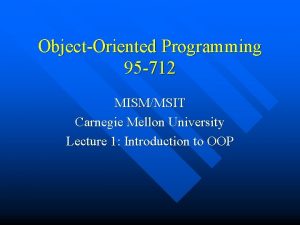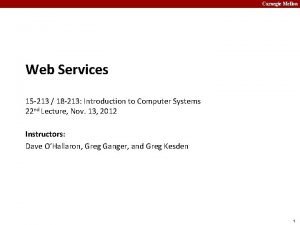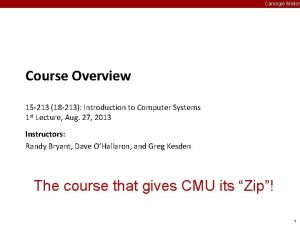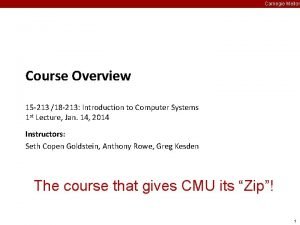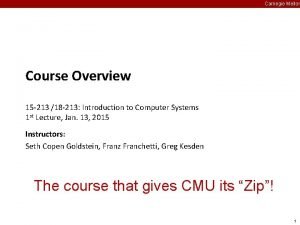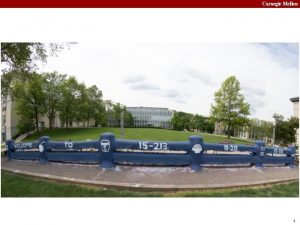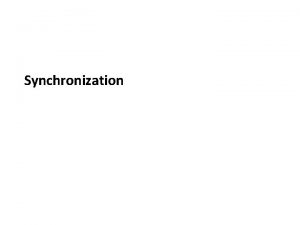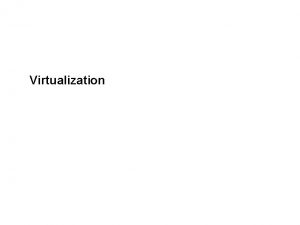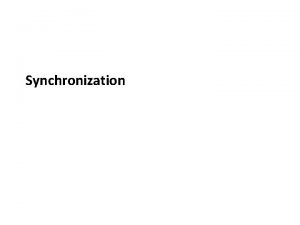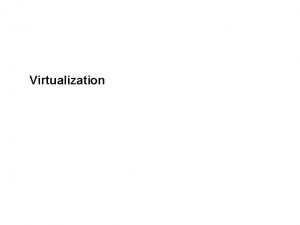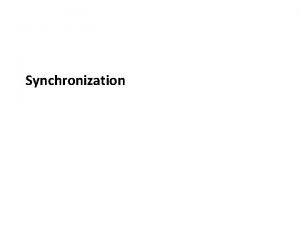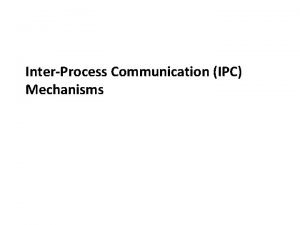Carnegie Mellon Course Overview 15 213 18 213







![Carnegie Mellon Memory Referencing Bug Example double fun(int i) { volatile double d[1] = Carnegie Mellon Memory Referencing Bug Example double fun(int i) { volatile double d[1] =](https://slidetodoc.com/presentation_image_h/30f0a3d6a74411da137f7d9620c88c71/image-8.jpg)
![Carnegie Mellon Memory Referencing Bug Example double fun(int i) { volatile double d[1] = Carnegie Mellon Memory Referencing Bug Example double fun(int i) { volatile double d[1] =](https://slidetodoc.com/presentation_image_h/30f0a3d6a74411da137f7d9620c88c71/image-9.jpg)


![Carnegie Mellon Memory System Performance Example void copyij(int src[2048], int dst[2048]) { int i, Carnegie Mellon Memory System Performance Example void copyij(int src[2048], int dst[2048]) { int i,](https://slidetodoc.com/presentation_image_h/30f0a3d6a74411da137f7d9620c88c71/image-12.jpg)





- Slides: 17

Carnegie Mellon Course Overview 15 -213 (18 -213): Introduction to Computer Systems 1 st Lecture, Aug. 26, 2014 Instructors: Greg Ganger, Greg Kesden, and Dave O’Hallaron The course that gives CMU its “Zip”! 1

Carnegie Mellon Overview Course theme ¢ Five realities ¢ How the course fits into the CS/ECE curriculum ¢ 2

Course Theme: Abstraction Is Good But Don’t Forget Reality ¢ Most CS and CE courses emphasize abstraction Carnegie Mellon § Abstract data types § Asymptotic analysis ¢ These abstractions have limits § Especially in the presence of bugs § Need to understand details of underlying implementations ¢ Useful outcomes from taking 213 § Become more effective programmers Able to find and eliminate bugs efficiently § Able to understand tune for program performance § Prepare for later “systems” classes in CS & ECE § Compilers, Operating Systems, Networks, Computer Architecture, Embedded Systems, Storage Systems, etc. § 3

Carnegie Mellon Great Reality #1: Ints are not Integers, Floats are not Reals 2 ¢ Example 1: Is x ≥ 0? § Float’s: Yes! § Int’s: 40000 * 40000 ➙ 1, 600, 000 § 50000 * 50000 ➙ ? ? § ¢ Example 2: Is (x + y) + z = x + (y + z)? § Unsigned & Signed Int’s: Yes! § Float’s: (1 e 20 + -1 e 20) + 3. 14 --> 3. 14 § 1 e 20 + (-1 e 20 + 3. 14) --> ? ? § Source: xkcd. com/571 4

Carnegie Mellon Computer Arithmetic ¢ Math does not generate random values § Arithmetic operations have important mathematical properties ¢ Cannot assume all “usual” mathematical properties § Due to finiteness of representations § Integer operations satisfy “ring” properties Commutativity, associativity, distributivity § Floating point operations satisfy “ordering” properties § Monotonicity, values of signs § ¢ Observation § Need to understand which abstractions apply in which contexts § Important issues for compiler writers and serious application programmers 5

Carnegie Mellon Great Reality #2: You’ve Got to Know Assembly ¢ Chances are, you’ll never write programs in assembly § Compilers are much better & more patient than you are ¢ But: Understanding assembly is key to machine-level execution model § Behavior of programs in presence of bugs High-level language models break down § Tuning program performance § Understand optimizations done / not done by the compiler § Understanding sources of program inefficiency § Implementing system software § Compiler has machine code as target § Operating systems must manage process state § Creating / fighting malware § x 86 assembly is the language of choice! § 6

Great Reality #3: Memory Matters Carnegie Mellon Random Access Memory Is an Unphysical Abstraction ¢ Memory is not unbounded § It must be allocated and managed § Many applications are memory dominated ¢ Memory referencing bugs especially pernicious § Effects are distant in both time and space ¢ Memory performance is not uniform § Cache and virtual memory effects can greatly affect program performance § Adapting program to characteristics of memory system can lead to major speed improvements 7
![Carnegie Mellon Memory Referencing Bug Example double funint i volatile double d1 Carnegie Mellon Memory Referencing Bug Example double fun(int i) { volatile double d[1] =](https://slidetodoc.com/presentation_image_h/30f0a3d6a74411da137f7d9620c88c71/image-8.jpg)
Carnegie Mellon Memory Referencing Bug Example double fun(int i) { volatile double d[1] = {3. 14}; volatile long int a[2]; a[i] = 1073741824; /* Possibly out of bounds */ return d[0]; } fun(0) fun(1) fun(2) fun(3) fun(4) ¢ ➙ ➙ ➙ 3. 14 3. 1399998664856 2. 00000061035156 3. 14, then segmentation fault Result is architecture specific 8
![Carnegie Mellon Memory Referencing Bug Example double funint i volatile double d1 Carnegie Mellon Memory Referencing Bug Example double fun(int i) { volatile double d[1] =](https://slidetodoc.com/presentation_image_h/30f0a3d6a74411da137f7d9620c88c71/image-9.jpg)
Carnegie Mellon Memory Referencing Bug Example double fun(int i) { volatile double d[1] = {3. 14}; volatile long int a[2]; a[i] = 1073741824; /* Possibly out of bounds */ return d[0]; } fun(0) fun(1) fun(2) fun(3) fun(4) ➙ ➙ ➙ Explanation: 3. 14 3. 1399998664856 2. 00000061035156 3. 14, then segmentation fault Saved State 4 d 7. . . d 4 3 d 3. . . d 0 2 a[1] 1 a[0] 0 Location accessed by fun(i) 9

Carnegie Mellon Memory Referencing Errors ¢ C and C++ do not provide any memory protection § Out of bounds array references § Invalid pointer values § Abuses of malloc/free ¢ Can lead to nasty bugs § Whether or not bug has any effect depends on system and compiler § Action at a distance Corrupted object logically unrelated to one being accessed § Effect of bug may be first observed long after it is generated § ¢ How can I deal with this? § Program in Java, Ruby, Python, ML, … § Understand what possible interactions may occur § Use or develop tools to detect referencing errors (e. g. Valgrind) 10

Great Reality #4: There’s more to performance than asymptotic complexity Carnegie Mellon Constant factors matter too! ¢ And even exact op count does not predict performance ¢ § Easily see 10: 1 performance range depending on how code written § Must optimize at multiple levels: algorithm, data representations, procedures, and loops ¢ Must understand system to optimize performance § How programs compiled and executed § How to measure program performance and identify bottlenecks § How to improve performance without destroying code modularity and generality 11
![Carnegie Mellon Memory System Performance Example void copyijint src2048 int dst2048 int i Carnegie Mellon Memory System Performance Example void copyij(int src[2048], int dst[2048]) { int i,](https://slidetodoc.com/presentation_image_h/30f0a3d6a74411da137f7d9620c88c71/image-12.jpg)
Carnegie Mellon Memory System Performance Example void copyij(int src[2048], int dst[2048]) { int i, j; for (i = 0; i < 2048; i++) for (j = 0; j < 2048; j++) dst[i][j] = src[i][j]; } 5. 2 ms void copyji(int src[2048], int dst[2048]) { int i, j; for (j = 0; j < 2048; j++) for (i = 0; i < 2048; i++) dst[i][j] = src[i][j]; } 2. 8 GHz Intel Core i 7 162 ms Hierarchical memory organization ¢ Performance depends on access patterns ¢ § Including how step through multi-dimensional array 12

Great Reality #5: Computers do more than execute programs ¢ Carnegie Mellon They need to get data in and out § I/O system critical to program reliability and performance ¢ They communicate with each other over networks § Many system-level issues arise in presence of network Concurrent operations by autonomous processes § Coping with unreliable media § Cross platform compatibility § Complex performance issues § 13

Carnegie Mellon Role within CS/ECE Curriculum ECE 545/549 Capstone CS 412 OS Practicum CS 415 Databases CS 441 Networks Data Reps. Memory Model CS 440 Distributed systems CS 410 Operating Systems Network Protocols Network Prog Concurrency CS 411 Compilers ECE 340 Digital Computation Processes Machine Mem. Mgmt Code Arithmetic 213 ECE 447 Architecture ECE 349 Embedded Systems ECE 348 Embedded System Eng. Execution Model Memory System Foundation of Computer Systems Underlying principles for hardware, software, and networking CS 122 Imperative Programming 14

Carnegie Mellon Course Perspective ¢ Most Systems Courses are Builder-Centric § Operating Systems Implement large portions of operating system Distributed Systems § Build services and applications that use multiple computers Embedded Systems § Develop control software for embedded hardware Compilers § Write compiler for simple language Computer Architecture § Design pipelined processor in Verilog Networking § Implement and simulate network protocols § § § 15

Carnegie Mellon Course Perspective (Cont. ) ¢ Our Course is Programmer-Centric § Purpose is to show that by knowing more about the underlying system, one can be more effective as a programmer § Enable you to § Write programs that are more reliable and efficient § Incorporate features that require hooks into OS – E. g. , concurrency, signal handlers § Cover material in this course that you won’t see elsewhere § Not just a course for dedicated hackers § We bring out the hidden hacker in everyone! 16

Carnegie Mellon Teaching staff Greg Ganger Dave O’Hallaron Greg Kesden 17
 Carnegie mellon
Carnegie mellon 15-513 cmu
15-513 cmu Randy pausch time management slides
Randy pausch time management slides Cmu computational biology
Cmu computational biology Carnegie mellon vpn
Carnegie mellon vpn Carnegie mellon software architecture
Carnegie mellon software architecture Carnegie mellon
Carnegie mellon Robotic ankle
Robotic ankle Carnegie mellon interdisciplinary
Carnegie mellon interdisciplinary Carnegie mellon
Carnegie mellon Carnegie mellon
Carnegie mellon Cmu sparcs
Cmu sparcs Iit
Iit Carnegie mellon software architecture
Carnegie mellon software architecture Carnegie mellon
Carnegie mellon Carnegie mellon fat letter
Carnegie mellon fat letter Cmu mism
Cmu mism Carnegie mellon
Carnegie mellon
